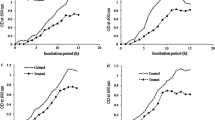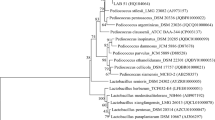Abstract
Vibrio parahaemolyticus: is recognized as the main cause of gastroenteritis associated with consumption of seafood. Bacteriocin-producing Lactobacillus plantarum FGC-12 isolated from golden carp intestine had strong antibacterial activity toward V. parahaemolyticus. The fish-borne bacteriocin was purified by a three-step procedure consisting of ethyl acetate extraction, gel filtration chromatography and high performance liquid chromatography. Its molecular weight was estimated at 4.1 kDa using SDS-PAGE. The fish-borne bacteriocin reached the maximum production at stationary phase after 20 h. It was heat-stable (30 min at 121 °C) and remained active at pH range from 3.0 to 5.5, but was sensitive to nutrasin, papain and pepsin. Its minimum inhibitory concentration for V. parahaemolyticus was 6.0 mg/ml. Scanning electron microscopy analysis showed that the fish-borne bacteriocin disrupted cell wall of V. parahaemolyticus. The antibacterial mechanism of the fish-borne bacteriocin against V. parahaemolyticus might be described as action on membrane integrity in terms of the leakage of electrolytes, the losses of Na+K+-ATPase, AKP and proteins. The addition of the fish-borne bacteriocin to shrimps leaded V. parahaemolyticus to reduce 1.3 log units at 4 °C storage for 6 day. Moreover, a marked decline in total volatile base nitrogen and total viable counts was observed in bacteriocin treated samples than the control. It is clear that this fish-borne bacteriocin has promising potential as biopreservation for the control of V. parahaemolyticus in aquatic products.





Similar content being viewed by others
References
Anacarso I, Messi P, Condò C, Iseppi R, Bondi M, Sabia C, de Niederhäusern S (2014) A bacteriocin-like substance produced from Lactobacillus pentosus 39 is a natural antagonist for the control of Aeromonas hydrophila and Listeria monocytogenes in fresh salmon fillets. LWT-Food Sci Technol 55:604–611
Atrih A, Rekhif N, Moir AJG, Lebrihi A, Lefebvre G (2001) Mode of action, purification and amino acid sequence of plantaricin C19, an anti-Listeria bacteriocin produced by Lactobacillus plantarum C19. Int J Food Microbiol 68:93–104
Banerjee SP, Dora KC, Chowdhury S (2011) Detection, partial purification and characterization of bacteriocin produced by Lactobacillus brevis FPTLB3 isolated from freshwater fish. J Food Sci Technol 50:17–25
Bhunia AK, Johnson MC, Ray B, Kalchayanand N (1991) Mode of action of pediocin AcH from Pediococcus acidilactici H on sensitive bacterial strains. J Appl Microbiol 70:25–33
Bradford MM (1976) A rapid and sensitive method for the quantitation of microgram quantities of protein utilizing the principle of protein-dye binding. Anal Biochem 72:248–254
Campos CA, Rodríguez Ó, Calo-Mata P, Prado M, Barros-Velázquez J (2006) Preliminary characterization of bacteriocins from Lactococcus lactis, Enterococcus faecium and Enterococcus mundtii strains isolated from turbot (Psetta maxima). Food Res Int 39:356–364
Castellano P (2003) Mode of action of lactocin 705, a two-component bacteriocin from Lactobacillus casei CRL705. Int J Food Microbiol 85:35–43
Castro MP, Palavecino NZ, Herman C, Garro OA, Campos CA (2011) Lactic acid bacteria isolated from artisanal dry sausages: characterization of antibacterial compounds and study of the factors affecting bacteriocin production. Meat Sci 87:321–329
Chahad OB, El Bour M, Calo-Mata P, Boudabous A, Barros-Velazquez J (2012) Discovery of novel biopreservation agents with inhibitory effects on growth of food-borne pathogens and their application to seafood products. Res Microbiol 163:44–54
Cheikhyoussef A, Pogori N, Chen H, Tian F, Chen W, Tang J, Zhang H (2009) Antimicrobial activity and partial characterization of bacteriocin-like inhibitory substances (BLIS) produced by Bifidobacterium infantis BCRC 14602. Food Control 20:553–559
China Nation Center for Food Safety Risk Assessment (CFSA) (2015) http://www.cnfoodsafety.com/2015/0430/10882.html
Devi Avaiyarasi N, David Ravindran A, Venkatesh P, Arul V (2016) In vitro selection, characterization and cytotoxic effect of bacteriocin of Lactobacillus sakei GM3 isolated from goat milk. Food Control 69:124–133
Diao W-R, Hu Q-P, Zhang H, Xu J-G (2014) Chemical composition, antibacterial activity and mechanism of action of essential oil from seeds of fennel (Foeniculum vulgare Mill.). Food Control 35:109–116
Elmahdi S, DaSilva LV, Parveen S (2016) Antibiotic resistance of Vibrio parahaemolyticus and Vibrio vulnificus in various countries: a review. Food Microbiol 57:128–134
Ennahar S, Sashihara T, Sonomoto K, Ishizaki A (2000) Class IIa bacteriocins: biosynthesis, structure and activity. FEMS Microbiol Rev 24:85–106
Gao Y, Li D, Sheng Y, Liu X (2011) Mode of action of sakacin C2 against Escherichia coli. Food Control 22:657–661
Gao Y, Li D, Liu S, Zhang L (2015) Garviecin LG34, a novel bacteriocin produced by Lactococcus garvieae isolated from traditional Chinese fermented cucumber. Food Control 50:896–900
Gui M, Zhao B, Song J, Zhang Z, Peng Z, Li P (2014) Paraplantaricin L-ZB1, a novel bacteriocin and its application as a biopreservative agent on quality and shelf life of rainbow trout fillets stored at 4 degrees c. Appl Biochem Biotech 174:2295–2306
Han N, Mizan MFR, Jahid IK, Ha S-D (2016) Biofilm formation by Vibrio parahaemolyticus on food and food contact surfaces increases with rise in temperature. Food Control 70:161–166
H-Kittikun A et al (2015) Bacteriocin-producing Enterococcus faecalis KT2W2G isolated from mangrove forests in southern Thailand: purification, characterization and safety evaluation. Food Control 54:126–134
Hu M, Zhao H, Zhang C, Yu J, Lu Z (2013) Purification and characterization of plantaricin 163, a novel bacteriocin produced by Lactobacillus plantarum 163 isolated from traditional Chinese fermented vegetables. J Agr Food Chem 61:11676–11682
Kaewklom S, Lumlert S, Kraikul W, Aunpad R (2013) Control of Listeria monocytogenes on sliced bologna sausage using a novel bacteriocin, amysin, produced by Bacillus amyloliquefaciens isolated from Thai shrimp paste (Kapi). Food Control 32:552–557
Kumar BK, Deekshit VK, Raj JRM, Rai P, Shivanagowda BM, Karunasagar I, Karunasagar I (2014) Diversity of Vibrio parahaemolyticus associated with disease outbreak among cultured Litopenaeus vannamei (Pacific white shrimp) in India. Aquaculture 433:247–251
Liu G, Ren L, Song Z, Wang C, Sun B (2015) Purification and characteristics of bifidocin A, a novel bacteriocin produced by Bifidobacterium animals BB04 from centenarians’ intestine. Food Control 50:889–895
Liu G, Song Z, Yang X, Gao Y, Wang C, Sun B (2016a) Antibacterial mechanism of bifidocin A, a novel broad-spectrum bacteriocin produced by Bifidobacterium animalis BB04. Food Control 62:309–316
Liu X, Jia Y, Hu Y, Xia X, Li Y, Zhou J, Liu Y (2016b) Effect of Citrus wilsonii Tanaka extract combined with alginate-calcium coating on quality maintenance of white shrimps (Litopenaeus vannamei Boone). Food Control 68:83–91
Lü X, Hu P, Dang Y, Liu B (2014) Purification and partial characterization of a novel bacteriocin produced by Lactobacillus casei TN-2 isolated from fermented camel milk (Shubat) of Xinjiang Uygur Autonomous region, China. Food Control 43:276–283
Miget RJ (1991) Microbiology of crustacean processing: shrimp, crawfish, and prawns. In Ward DR (ed) Microbioliogy of marine food products. Springer, New York, p 65–87
Nirmal NP, Benjakul S (2010) Effect of catechin and ferulic acid on melanosis and quality of Pacific white shrimp subjected to prior freeze–thawing during refrigerated storage. Food Control 21:1263–1271
Paari A, Paulraj K, Ramraj S, Neelkandan Y, Vellaiyan P, Siva P, Venkatesan A (2011) Biopreservation of Sardinella longiceps and Penaeus monodon using protective culture Streptococcus phocae PI 80 isolated from marine shrimp Penaeus indicus. Probiotics Antimicrob 3:103–111
Pinto A, Fernandes M, Pinto C, Albano H, Castilho F, Teixeira P, Gibbs P (2009) Characterization of anti-Listeria bacteriocins isolated from shellfish: potential antimicrobials to control non-fermented seafood. Int J Food Microbiol 129:50–58
Pu Y et al (2013) Modeling inhibitory activity of a novel antimicrobial peptide AMPNT-6 from Bacillus subtilis against Vibrio parahaemolyticus in shrimp under various environmental conditions. Food Control 33:249–253
Rekhif N, Atrih A, Lefebvre G (1994) Characterization and partial purification of plantaricin LC74, a bacteriocin produced by Lactobacillus plantarum LC74. Biotechnol Lett 16:771–776
Satish KR, Arul V (2009) Purification and characterization of phocaecin PI80: an anti-listerial bacteriocin produced by Streptococcus phocae PI80 Isolated from the gut of Peneaus indicus (Indian white shrimp). J Microbiol Biotechnol 19:1393
Sequeiros C, Vallejo M, Marguet ER, Olivera NL (2010) Inhibitory activity against the fish pathogen Lactococcus garvieae produced by Lactococcus lactis TW34, a lactic acid bacterium isolated from the intestinal tract of a Patagonian fish. Arch Microbiol 192:237–245
Shi F, Wang Y, Li Y, Wang X (2016) Mode of action of leucocin K7 produced by Leuconostoc mesenteroides K7 against Listeria monocytogenes and its potential in milk preservation. Biotechnol Lett 38:1551–1557
Su Y-C, Liu C (2007) Vibrio parahaemolyticus: a concern of seafood safety. Food Microbiol 24:549–558
Tiwari SK, Srivastava S (2008) Purification and characterization of plantaricin LR14: a novel bacteriocin produced by Lactobacillus plantarum LR/14. Appl Microbiol Biot 79:759–767
Tiwari SK, Sutyak NK, Cavera VL, Chikindas ML (2015) Improved antimicrobial activities of synthetic-hybrid bacteriocins designed from enterocin E50-52 and pediocin PA-1. Appl Environ Microb 81:1661–1667
Todorov SD, Dicks LMT (2005) Effect of growth medium on bacteriocin production by Lactobacillus plantarum ST194BZ, a strain isolated from Boza. Food Technol Biotech 43:165–173
Todorov SD, Ho P, Vaz-Velho M, Dicks LM (2010) Characterization of bacteriocins produced by two strains of Lactobacillus plantarum isolated from Beloura and Chourico, traditional pork products from Portugal. Meat Sci 84:334–343
Wen LS, Philip K, Ajam N (2016) Purification, characterization and mode of action of plantaricin K25 produced by Lactobacillus plantarum. Food Control 60:430–439
Xu D, Wang Y, Sun L, Liu H, Li J (2013) Inhibitory activity of a novel antibacterial peptide AMPNT-6 from Bacillus subtilis against Vibrio parahaemolyticus in shrimp. Food Control 30:58–61
Yang R, Johnson MC, Ray B (1992) Novel method to extract large amounts of bacteriocins from lactic acid bacteria. Appl Environ Microb 58:3355–3359
Yi L, Dang J, Zhang L, Wu Y, Liu B, Lü X (2016) Purification, characterization and bactericidal mechanism of a broad spectrum bacteriocin with antimicrobial activity against multidrug-resistant strains produced by Lactobacillus coryniformis XN8. Food Control 67:53–62
Zhang X, Wang Y, Liu L, Wei Y, Shang N, Zhang X, Li P (2016a) Two-peptide bacteriocin PlnEF causes cell membrane damage to Lactobacillus plantarum. BBA-Biomembr 1858:274–280
Zhang Y, Liu X, Wang Y, Jiang P, Quek S (2016b) Antibacterial activity and mechanism of cinnamon essential oil against Escherichia coli and Staphylococcus aureus. Food Control 59:282–289
Zhou K, Zhou W, Li P, Liu G, Zhang J, Dai Y (2008) Mode of action of pentocin 31-1: an antilisteria bacteriocin produced by Lactobacillus pentosus from Chinese traditional ham. Food Control 19:817–822
Acknowledgements
This study was supported by the Fundamental Research Funds for the Central Universities (No. 2015ZCQ-SW-05) and the Research Project from Science & Technology Department of Liaoning Province of China (No. 2015103020).
Author information
Authors and Affiliations
Corresponding authors
Rights and permissions
About this article
Cite this article
Lv, X., Du, J., Jie, Y. et al. Purification and antibacterial mechanism of fish-borne bacteriocin and its application in shrimp (Penaeus vannamei) for inhibiting Vibrio parahaemolyticus . World J Microbiol Biotechnol 33, 156 (2017). https://doi.org/10.1007/s11274-017-2320-8
Received:
Accepted:
Published:
DOI: https://doi.org/10.1007/s11274-017-2320-8




